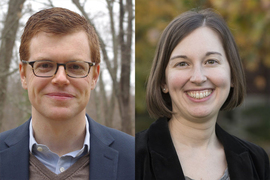In 2018, MIT convened its Task Force on the Work of the Future, which concluded in a 2020 report that while new technologies were not necessarily going to massively wipe out employment, smart practices and policies would be necessary to let automation complement good jobs. Today a successor group is continuing the task force’s effort: The Work of the Future Initiative, whose co-directors are Julie Shah, the H.N. Slater Professor of Aeronautics and Astronautics at MIT, and Ben Armstrong, executive director and research scientist at MIT’s Industrial Performance Center.
The Work of the Future Initiative is conducting research onsite at manufacturing firms and generating collaborative work on campus. Meanwhile, in a recent Harvard Business Review article, Shah and Armstrong outlined their vision of “positive-sum automation” in manufacturing, in which robots and automation co-exist with worker-driven input, rather than wipe out workers. They spoke with MIT News about their ideas.
Q: Let’s start with your perspective about how technologies and workers can complement each other. What is “positive-sum automation,” this core idea of the Work of the Future Initiative?
Ben Armstrong: One thing Julie and I both noticed from visiting factories and studying manufacturers, and that Julie noticed from her work developing robotics technologies, is the tradeoff between productivity advances, which is often the goal of automation, and flexibility. When firms become more productive in repetitive processes, they often lose flexibility. It becomes costlier to change production processes, or make adjustments for workers, even on the level of ergonomics. In short, “zero-sum automation” is a tradeoff, while “positive-sum automation” is using different technology design and strategy to get both productivity and flexibility.
This isn’t just important for firm performance, but for workers. A lot of firms adopting robots actually hire more workers. It’s an open question whether those jobs become better. So, by promoting flexibility as part of the automation process, that can be better for workers, including more worker input.
Julie Shah: I develop AI-enabled robots and have worked for much of my career in manufacturing, trying to cut against this paradigm where you make a choice between either a human doing the job or a robot doing the job, which is by definition zero-sum. It requires a very intentional effort in shaping the technology to make flexible sytems that improve productivity.
Q: How often do firms not realize that automation can lead to this kind of tradeoff?
Shah: The mistake is nearly ubiquitous. But as we toured firms for our research, we saw the ones that are successful at adopting and scaling the use of the robots have a very different mindset. The traditional way you think of labor displacement is, if I put this robot in, I take this person out. We were just in a factory where a worker is overseeing multiple robots, and he said, “Because my job got easier, I can now timeshare between multiple machines, and instead of being crazy busy, I can spend 20 percent of my time thinking about how to improve all of this.” The learning curve in the factory is driven by people and their ability to innovate.
Armstrong: It’s sometimes hard to measure the impact of a technology before it’s deployed. You don’t really know what hidden costs or benefits might emerge. Workers spending time more creatively on problems becomes a downstream benefit. In health care, for instance, automating administrative tasks might meet resistance, but in our interviews, workers talked about how they could now focus on the most interesting parts of their jobs, so we see an outcome that’s good for workers and also potentially good for continuous improvement at these firms.
The focus of the [Harvard Business Review] piece was hardware technologies, but firms can be very creative in how they connect their front-office software used to sell their product with the software that controls their machines. Another piece I’ve been interested in is logistics and warehousing, which in some ways has seen far greater advances in robotics and automation, and where there’s a lot of potential to improve job quality for people.
Q: In its current incarnation, what does the Work of the Future Initiative consist of?
Shah: The Work of the Future Initiative has what we call an “automation clinic,” where we bring researchers and students out to firms in manufacturing, to look at how companies might break out of their zero-sum choices and to showcase those success stories. But the initiative is broader than that. There are seed research efforts and other ways we engage faculty and research across the Institute.
Armstrong: We’re developing an open library of case studies, and we’re always looking for new places to visit and new industry partners to learn from. And we are looking for more structured opportunities for campus discussions. The Work of the Future Initiative is not a closed community, and we would very much like to reach out to people at MIT. It’s exciting and challenging to have people who run a robotics lab working with social scientists. It happens at MIT but might not happen at other places. We’re trying to spur more collaborations among people who look at the same questions in different ways.
Shah: When the Work of the Future task force started in 2018, there were billboards on I-90 telling people they’d better retire now [due to robots]. But what’s happening is much more nuanced. There are all these different possible futures as you deploy these technologies. It’s a large and long-term research agenda to ask about the organizational decisions that produce positives outcomes for firms and workers. That’s very motivating, I think, for people doing the engineering work, and involves broad engagement, and that’s what we’re aiming for.












